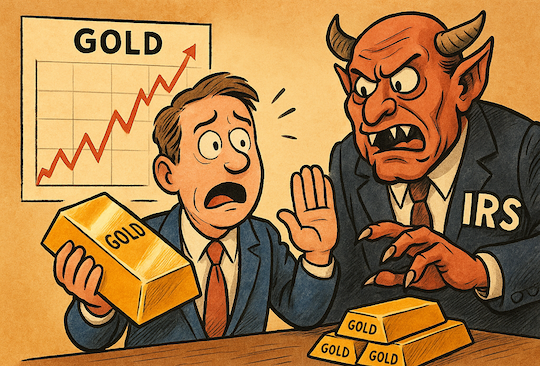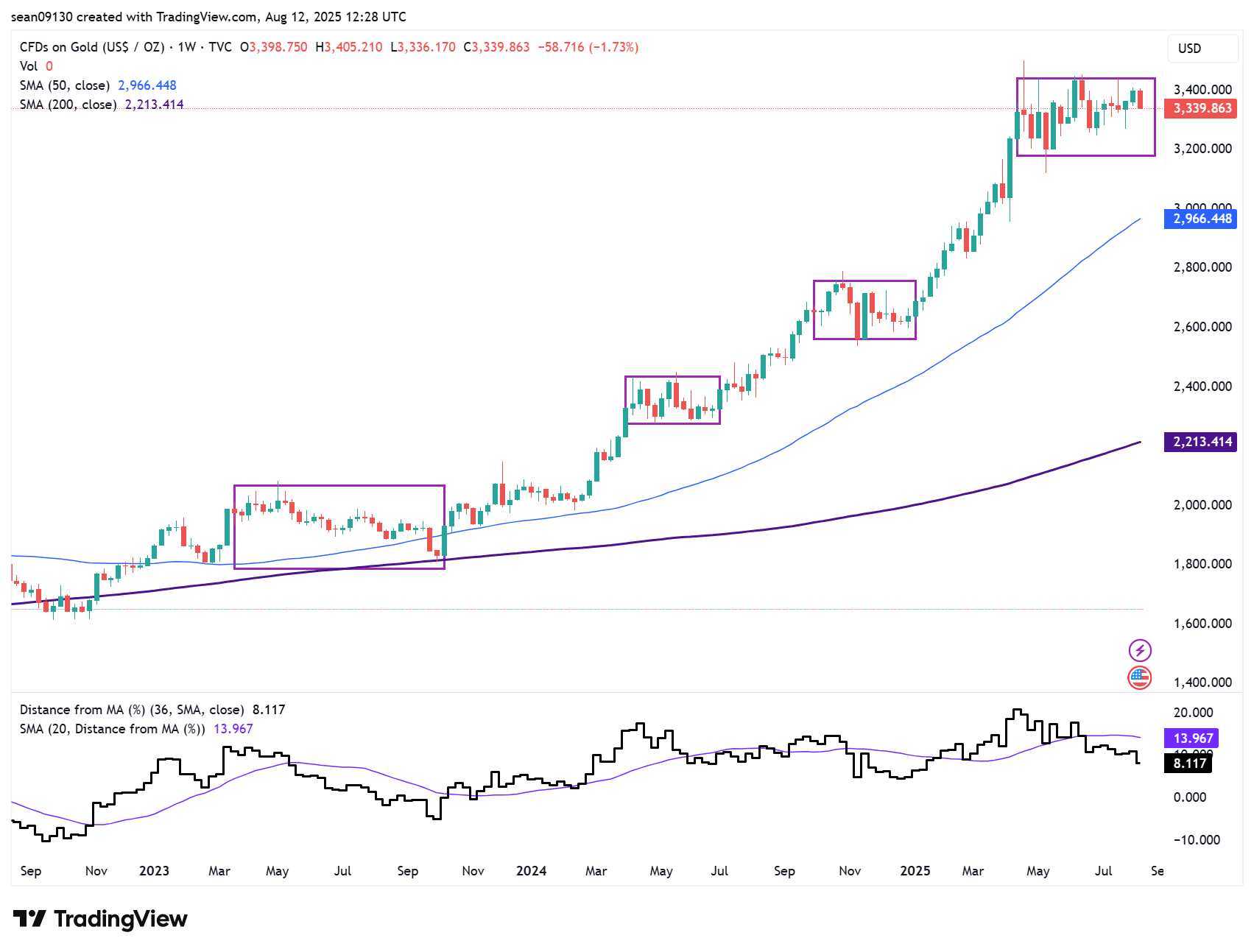
Posted August 13, 2025
By Sean Ring
Don’t Sell Your Gold — Not Yet
In the words of Sheriff Buford T. Justice, “You can think about it, but don’t do it!”
I get it. Human nature is wired for two things in markets: greed and fear. Greed gets you into trades, fear gets you out. Right now, people are afraid the gold party’s almost over.
Let me be clear: now is not the time to sell your gold.
In fact, there are three compelling reasons why selling right now would be a mistake — one rooted in market reality, one in the tax code, and one in the cold, hard logic of survival.
1. The Trend Is Still Your Friend
We’ll start with the most boring-sounding reason that’s actually the most important: gold is still in an uptrend.
I don’t mean a “sort of” uptrend. I mean a full-throttle, textbook, “technical analysts get misty-eyed just looking at the chart” uptrend.
- Higher highs, higher lows — the very definition of an uptrend.
- The 50-day moving average is comfortably above the 200-day moving average — the so-called “golden cross,” a bullish signal that even non-chartists take seriously.
- Momentum indicators like RSI and MACD aren’t screaming “overbought” yet — meaning there’s still room to run before traders start taking serious profits.

Even better, every pullback in gold over the last 12–18 months has been met with aggressive buying. The dips aren’t lasting long, and the breakouts are holding.
In other words: the market isn’t done. Not even close.
Not only that, but gold’s taking healthy breaks every once in a while.
If you look above again, you’ll see the “boxes” gold backs into when it roams too far above its moving average. Notice the bottom chart, which is the distance the price is from the 36-week moving average and the 20-week simple moving average of that distance. You’ll see that whenever gold is moving “sideways,” its price moves from overvalued versus the moving average to undervalued… then it takes off again.
Right now, we’re getting “undervalued” according to this metric. That means gold’s next up move will be around the corner.
And remember, selling into an established, healthy uptrend is like getting off a train halfway up a mountain because you think the scenery can’t possibly get any better. The whole point of trend-following is to stay in until the trend breaks. Right now, it hasn’t.
And just to twist the knife for anyone itching to sell: history shows that when gold finally breaks through a major resistance level and holds it, it often accelerates sharply. The biggest gains usually come after everyone thinks the easy money’s been made.
2. You Will Directly Finance the IRS.
Now, let’s talk about something that kills more investment gains than bad market timing: taxes.
When you sell gold, how you’re taxed depends on what form you own it in — and if you own physical gold, you’re in for a treat.
In the U.S., physical gold coins, bars, and in many cases gold-backed ETFs are treated as a collectible. That means it can be taxed at a long-term capital gains rate of up to 28%. That’s not just higher than the 15% or 20% you might pay on stocks — it’s a rate that can turn a great trade into a “meh” trade after you cut the check to Uncle Sam.
On top of that, selling physical gold often means accepting a price below the spot market. Dealers take a margin. Buyers factor in authenticity verification, storage costs, and their overhead.
If you own gold mining stocks or gold mutual funds, you may be in better shape — they’re taxed like normal stocks, meaning you might pay the standard long-term capital gains rate. But it’s still a taxable event.
Here’s the practical takeaway: unless you need the cash, selling gold means giving up a piece of your profit to the IRS immediately, and for physical gold, you’re handing over a larger-than-normal slice of the pie.
If you believe gold is going higher (and I do), then selling now is voluntarily taking on two hits: missing future gains and triggering a hefty tax bill. That’s financial lunacy.
3. Gold’s Job Isn’t Done
Gold is the financial equivalent of an insurance policy. It protects you from the things that destroy fiat currencies and destabilize financial systems. You know, minor inconveniences like runaway government debt and deficits, central bank mismanagement, currency devaluation, banking crises, political instability, and political blowups.
Unlike your stocks or bonds, gold doesn’t care about earnings season, interest rate decisions, or whether your government’s fiscal policy is “sustainable” (spoiler: it isn’t). Gold is apolitical, borderless, and unprintable.
When you hold physical gold, you hold something that has been universally accepted as a store of value for thousands of years, through wars, collapses, hyperinflations, and revolutions.
That role isn’t over. In fact, I’d argue we’re just entering the phase of this cycle where gold’s real value — not just its market price — becomes obvious.
Selling gold now because you’ve made a nice profit is like canceling your homeowner’s insurance because your house hasn’t caught fire yet. You might pocket some money today, but you’re leaving yourself exposed tomorrow.
The Most Dangerous Time to Sell
The most dangerous time to sell gold is when is working.
That’s because you’re selling into the very conditions that made it rise in the first place — and those conditions are often far from resolved.
Right now, the list of bullish drivers for gold is long:
- Central banks (especially in emerging markets) are buying at record levels.
- Global debt levels are at historic highs, with no credible plan to bring them down. And in the case of The Donald, no will to bring the debt down.
- Geopolitical tensions aren’t easing — they’re multiplying.
- The U.S. dollar’s status as the world’s reserve currency is facing its most serious challenges in decades. Think of the BRICS threat.
None of these forces is a short-term phenomenon. They’re slow-burning, structural issues — precisely the kind of backdrop in which gold tends to thrive.
Wrap Up
If you’re holding gold right now, you’re in a sweet spot: the chart looks great, the fundamentals are supportive, and the alternative assets are far less appealing.
Selling now would mean:
- Giving up on an intact uptrend that could easily have another leg higher.
- Triggering a painful tax bill (and possibly a haircut on the sale price).
- Losing the one asset in your portfolio that serves as an actual hedge against systemic risk.
So resist the urge to take profits too early. There’s an old trading adage: “Let your winners run.”
Right now, gold is running. Let it.
Because one day — maybe not tomorrow, maybe not next month — you’ll wake up to a headline or a market event that makes you think, “This is why I own gold.”
And when that day comes, you’ll be glad you didn’t sell.

Oil Off The Boil
Posted December 24, 2025
By Sean Ring

Gold Bars, Up Bars, and FUBAR
Posted December 23, 2025
By Sean Ring

EX-SQUEEZE ME!
Posted December 22, 2025
By Sean Ring

Swamp, Brains, and the Game
Posted December 19, 2025
By Sean Ring

WTI…WTF?
Posted December 18, 2025
By Sean Ring

